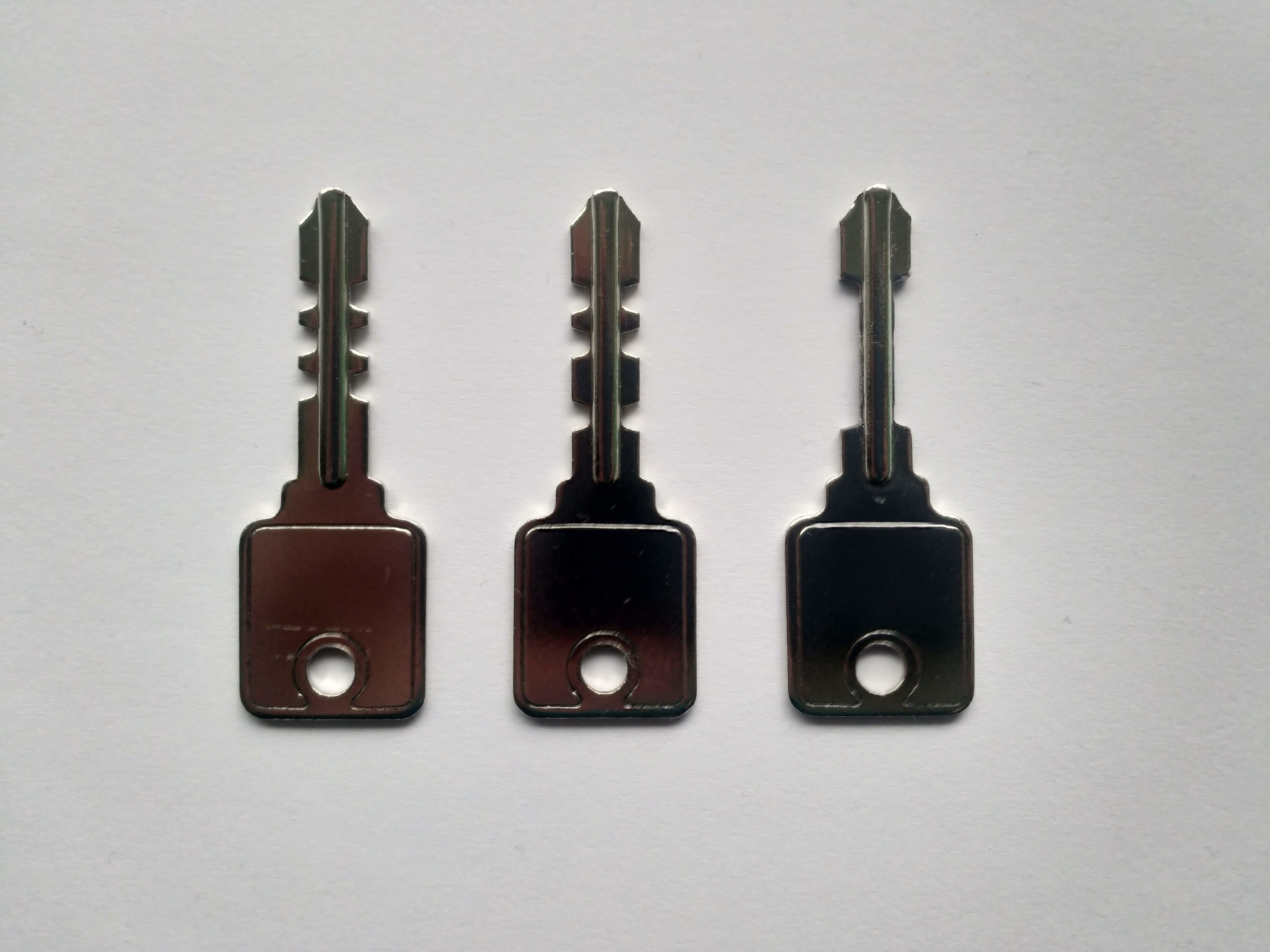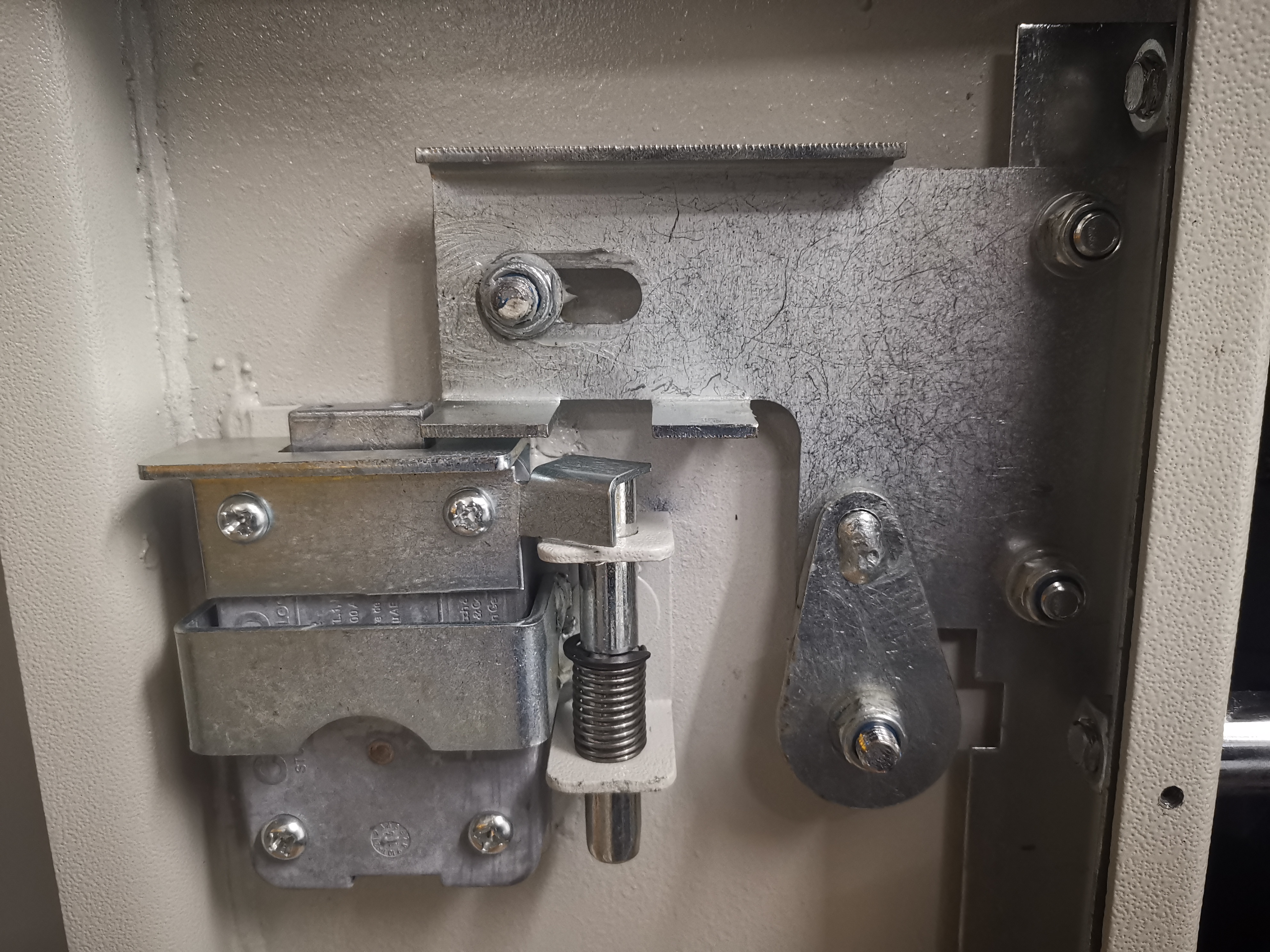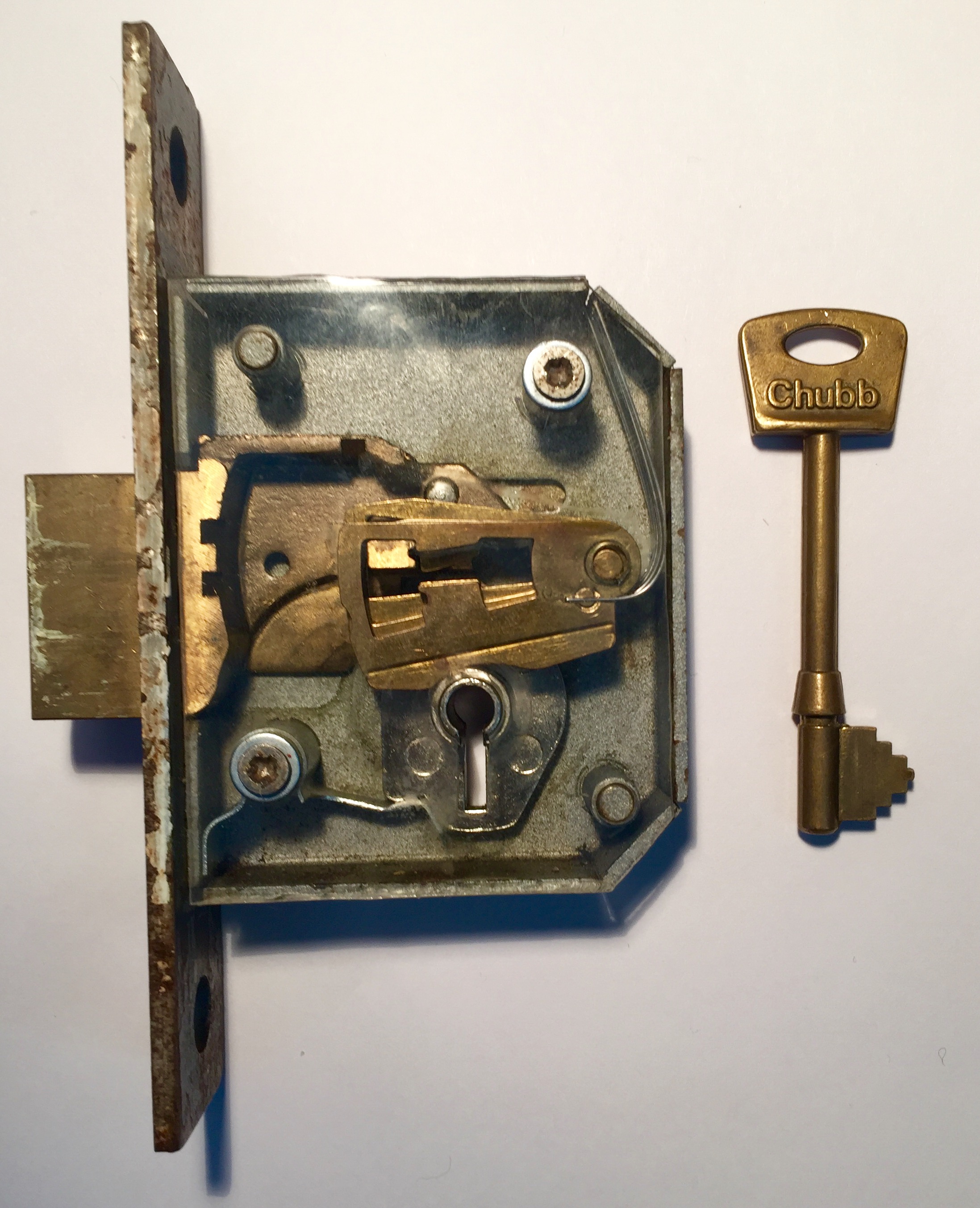|
Mortise Lock
A mortise lock (also spelled mortice lock in British English) is a lock that requires a pocket—the mortise—to be cut into the edge of the door or piece of furniture into which the lock is to be fitted. In most parts of the world, mortise locks are found on older buildings constructed before the advent of bored cylindrical locks, but they have recently become more common in commercial and upmarket residential construction in the United States. The design is widely used in domestic properties of all vintages in Europe. History Mortise locks have been used as part of door hardware systems in the US since the second quarter of the eighteenth century. In these early forms, the mortise lock mechanism was combined with a pull to open the unlocked door. Eventually, pulls were replaced by knobs. Until the mid-nineteenth century, mortise locks were only used in the most formal rooms in the most expensive houses. Other rooms used box locks or rim locks; in contrast with embedded mor ... [...More Info...] [...Related Items...] OR: [Wikipedia] [Google] [Baidu] |
Warded Lock
A warded lock (also called a ward lock) is a type of lock that uses a set of obstructions, or ''wards'', to prevent the lock from opening unless the correct key is inserted. The correct key has notches or slots corresponding to the obstructions in the lock, allowing it to rotate freely inside the lock. History The warded lock is one of the oldest lock designs, which can be found as far back as ancient China and Rome. During the Middle Ages they were used prolifically on monasteries where, because money and time were available, their complexity grew. Warded locks are still in use today in the UK and Ireland for low-security applications, and on heritage sites such as ancient monuments and churches to preserve original features, with primary security being provided by other means such as a lever lock mechanism installed in addition. Design In a basic warded lock, a set of obstructions, often consisting of concentric plates protruding outwards, blocks the rotation of a key not ... [...More Info...] [...Related Items...] OR: [Wikipedia] [Google] [Baidu] |
Woodworking
Woodworking is the skill of making items from wood, and includes cabinet making (cabinetry and furniture), wood carving, woodworking joints, joinery, carpentry, and woodturning. History Along with Rock (geology), stone, clay and animal parts, wood was one of the first materials worked by early humans. Lithic analysis, Microwear analysis of the Mousterian stone tools used by the Neanderthals show that many were used to work wood. The development of civilization was closely tied to the development of increasingly greater degrees of skill in working these materials. Among early finds of wooden tools are the worked sticks from Kalambo Falls, Clacton-on-Sea and Lehringen. The spears from Schöningen (Germany) provide some of the first examples of wooden hunting gear. Flint tools were used for carving. Since Neolithic, Neolithic times, carved wooden vessels are known, for example, from the Linear Pottery culture water well, wells at Kückhofen and Eythra. Examples of Bronze Age woo ... [...More Info...] [...Related Items...] OR: [Wikipedia] [Google] [Baidu] |
Strike Plate
This is a glossary of locksmithing terms. Glossary References External links {{Locksmithing Locksmithing Locksmithing is the science and art of making and defeating locks. Locksmithing is a traditional trade and in many countries requires completion of an apprenticeship. The level of formal education legally required varies from country to country ... Locksmithing ... [...More Info...] [...Related Items...] OR: [Wikipedia] [Google] [Baidu] |
Lever
A lever is a simple machine consisting of a beam or rigid rod pivoted at a fixed hinge, or ''fulcrum''. A lever is a rigid body capable of rotating on a point on itself. On the basis of the locations of fulcrum, load and effort, the lever is divided into three types. Also, leverage is mechanical advantage gained in a system. It is one of the six simple machines identified by Renaissance scientists. A lever amplifies an input force to provide a greater output force, which is said to provide leverage. The ratio of the output force to the input force is the mechanical advantage of the lever. As such, the lever is a mechanical advantage device, trading off force against movement. Etymology The word "lever" entered English around 1300 from Old French, in which the word was ''levier''. This sprang from the stem of the verb ''lever'', meaning "to raise". The verb, in turn, goes back to the Latin ''levare'', itself from the adjective ''levis'', meaning "light" (as in "not heavy"). The ... [...More Info...] [...Related Items...] OR: [Wikipedia] [Google] [Baidu] |
Doorknob
A door handle or doorknob is a handle used to open or close a door. Door handles can be found on all types of doors including exterior doors of residential and commercial buildings, internal doors, cupboard doors and vehicle doors. There are many designs of door handle, depending on the appropriate use. A large number of handles, particularly for commercial and residential doors, incorporate latching or locking mechanisms or are manufactured to fit to standardised door locking or latching mechanisms. The most common types of door handle are the lever handle and the doorknob. Door handles can be made out of a plethora of materials. Examples include brass, porcelain, cut glass, wood, and bronze. Door handles have been in existence for at least 5000 years, and its design has evolved since, with more advanced mechanism, types, and designs made. Some door handles are also arm- or foot-operated to reduce transmission of contagious illnesses. Types *The most common type of door hand ... [...More Info...] [...Related Items...] OR: [Wikipedia] [Google] [Baidu] |
Euro Cylinder
The pin tumbler lock is a lock mechanism that uses pins of varying lengths to prevent the lock from opening without the correct key. Pin tumblers are most commonly employed in cylinder locks, but may also be found in tubular pin tumbler locks (also known as radial locks or ace locks). History The first known example of a tumbler lock was found in the ruins of the Palace of Khorsabad built by king Sargon II (721–705 BC.) in Iraq.James, Peter, and I. J. Thorpe. Ancient Inventions. New York: Ballantine, 1994. Basic principles of the pin tumbler lock may date as far back as 2000 BC in Egypt; the lock consisted of a wooden post affixed to the door and a horizontal bolt that slid into the post. The bolt had vertical openings into which a set of pins fitted. These could be lifted, using a key, to a sufficient height to allow the bolt to move and unlock the door. This wooden lock was one of Egypt's major developments in domestic architecture during classical times. Such a ... [...More Info...] [...Related Items...] OR: [Wikipedia] [Google] [Baidu] |
Lever Tumbler Lock
A lever tumbler lock is a type of lock that uses a set of levers to prevent the bolt from moving in the lock. In the simplest form of these, lifting the tumbler above a certain height will allow the bolt to slide past. The number of levers may vary, but is usually an odd number for a lock that can be opened from each side of the door in order to provide symmetry. A minimum number of levers may be specified to provide an anticipated level of security (see five-lever locks section). History "Double acting" lever tumbler locks were invented in 1778 by Robert Barron of England. These required the lever to be lifted to a certain height by having a slot cut in the lever, so lifting the lever too far was as bad as not lifting the lever far enough. This type of lock is still used today, on doors in Europe, Africa, South America and some other parts of the world. Design The lock is made up of levers (usually made out of non-ferrous metals). Each lever needs to be lifted to a specifi ... [...More Info...] [...Related Items...] OR: [Wikipedia] [Google] [Baidu] |
Pin Tumbler Lock
The pin tumbler lock is a lock mechanism that uses pins of varying lengths to prevent the lock from opening without the correct key. Pin tumblers are most commonly employed in cylinder locks, but may also be found in tubular pin tumbler locks (also known as radial locks or ace locks). History The first known example of a tumbler lock was found in the ruins of the Palace of Khorsabad built by king Sargon II (721–705 BC.) in Iraq.James, Peter, and I. J. Thorpe. Ancient Inventions. New York: Ballantine, 1994. Basic principles of the pin tumbler lock may date as far back as 2000 BC in Egypt; the lock consisted of a wooden post affixed to the door and a horizontal bolt that slid into the post. The bolt had vertical openings into which a set of pins fitted. These could be lifted, using a key, to a sufficient height to allow the bolt to move and unlock the door. This wooden lock was one of Egypt's major developments in domestic architecture during classical times. Such a ... [...More Info...] [...Related Items...] OR: [Wikipedia] [Google] [Baidu] |
Linus Yale Jr
Linus Yale Jr. (April 4, 1821 – December 25, 1868) was an American mechanical engineer, manufacturer, and co-founder with Henry R. Towne of the Yale Lock Manufacturing Company Yale is one of the world's oldest lock manufacturers, owned by its parent company, Assa Abloy. Over its extensive history, Yale has received patents for dozens of its products, and the company has distributed its products to more than 120 coun ..., which became the premier manufacturer of locks in the United States. He is best known for his inventions of Lock (security device), locks, especially the cylinder lock. His basic lock design is still widely distributed today, and constitutes a majority of personal locks and safes. Biography Youth Linus Yale Jr. was born in Salisbury, New York. His ancestors were of the same family as Elihu Yale, the benefactor to and namesake of the well known Yale University, as the Yales of America were all descended from the same ancestor, Fundamental Agreeme ... [...More Info...] [...Related Items...] OR: [Wikipedia] [Google] [Baidu] |
Pin Tumbler With Key
A pin is a device used for fastening objects or material together. Pin or PIN may also refer to: Computers and technology * Personal identification number (PIN), to access a secured system ** PIN pad, a PIN entry device * PIN, a former Dutch debit card system * An image on Pinterest * PIN diode, a semiconductor diode * Pin, a short lead in electronics * Pinning, the act of attaching a social media post to the top of a page to signify importance * To pin an object to another object in interface, such as pinning an application to the taskbar * Pin (computer program), a platform for creating analysis tools Awards, brooches, or fasteners * Award pin, recognising an achievement * Bobby pin or kirby grip or hair grip, a hairpin * Clevis pin, a three-piece fastener system * Collar pin, for a shirt collar * Drawing pin or thumbtack * Lapel pin, a small pin worn on clothing * Pin-back button, a badge fastened to garments with a safety pin. * Safety pin, pin which includes a simple spring ... [...More Info...] [...Related Items...] OR: [Wikipedia] [Google] [Baidu] |
Lever Tumbler Lock
A lever tumbler lock is a type of lock that uses a set of levers to prevent the bolt from moving in the lock. In the simplest form of these, lifting the tumbler above a certain height will allow the bolt to slide past. The number of levers may vary, but is usually an odd number for a lock that can be opened from each side of the door in order to provide symmetry. A minimum number of levers may be specified to provide an anticipated level of security (see five-lever locks section). History "Double acting" lever tumbler locks were invented in 1778 by Robert Barron of England. These required the lever to be lifted to a certain height by having a slot cut in the lever, so lifting the lever too far was as bad as not lifting the lever far enough. This type of lock is still used today, on doors in Europe, Africa, South America and some other parts of the world. Design The lock is made up of levers (usually made out of non-ferrous metals). Each lever needs to be lifted to a specifi ... [...More Info...] [...Related Items...] OR: [Wikipedia] [Google] [Baidu] |






.jpg)


